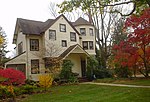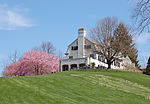Saturday Club (Wayne, Pennsylvania)
1899 establishments in PennsylvaniaBuildings and structures in Delaware County, PennsylvaniaClubhouses on the National Register of Historic Places in PennsylvaniaCultural infrastructure completed in 1899Delaware County, Pennsylvania Registered Historic Place stubs ... and 4 more
History of women in PennsylvaniaNational Register of Historic Places in Delaware County, PennsylvaniaTudor Revival architecture in PennsylvaniaWomen's clubs in the United States

Saturday Club is a historic women's club clubhouse located at Wayne, Delaware County, Pennsylvania. It was built in 1899, and is a 1 1/2-story, English Half Timber frame building. It measures approximately 55 feet by 75 feet, and has a gable roof with three gabled dormers. Its appearance is patterned after Shakespeare's Birthplace in Stratford-on-Avon, England.It was added to the National Register of Historic Places in 1978.
Excerpt from the Wikipedia article Saturday Club (Wayne, Pennsylvania) (License: CC BY-SA 3.0, Authors, Images).Saturday Club (Wayne, Pennsylvania)
West Wayne Avenue, Radnor Township
Geographical coordinates (GPS) Address Nearby Places Show on map
Geographical coordinates (GPS)
| Latitude | Longitude |
|---|---|
| N 40.043333333333 ° | E -75.389166666667 ° |
Address
The Saturday Club (1898)
West Wayne Avenue
19087 Radnor Township
Pennsylvania, United States
Open on Google Maps








